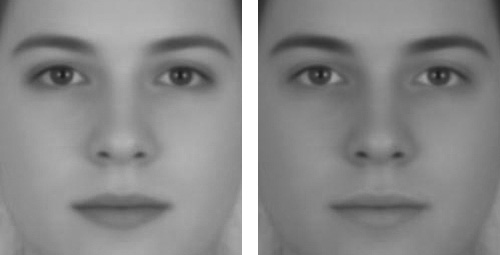In baseball, a curveball creates a physical effect and a perceptual puzzle. The physical effect (the curve) arises because the ball’s rotation leads to a deflection in the ball’s path. The perceptual puzzle arises because the deflection is actually gradual but is often perceived as an abrupt change in direction (the break). Our illusions suggest that the perceived “break” may be caused by the transition from the central visual system to the peripheral visual system. Like a curveball, the spinning disks in the illusions appear to abruptly change direction when an observer switches from foveal to peripheral viewing.
Color dove illusion
Fix your gaze on the central black point on the bird, as well as while the sky flashes. When the bird starts to fly, follow it, and keep staring at the black fixation point. You’ll start to notice, that the “empty bird” is filled-in with a color similar to the previous background’s color. The colored image produces illusory colors, an afterimage on “empty” shape, which induces an effect opposite to the well known “afterimage” effect. The common “afterimage” effect yields perceived complementary color, whereas the current effect shows an appearance of a color similar to that of the background, where originally, no physical color was present in the empty shape.
The illusion of sex

In the Illusion of Sex, two faces are perceived as male and female. However, both faces are actually versions of the same androgynous face. One face was created by increasing the contrast of the androgynous face, while the other face was created by decreasing the contrast. The face with more contrast is perceived as female, while the face with less contrast is perceived as male. The Illusion of Sex demonstrates that contrast is an important cue for perceiving the sex of a face, with greater contrast appearing feminine, and lesser contrast appearing masculine.
Russell, R. (2009) A sex difference in facial pigmentation and its exaggeration by cosmetics. Perception, (38)1211-1219.
Cubistic lands
A configuration of alternating dark and light gray shapes positioned in counterphase at the opposite side of a dividing line leads to distinct perceptual outcomes, depending on background luminance. With backgrounds of extreme luminance (black/white), the shapes appear independent and joining at the corner. Backgrounds of intermediate luminance unify the shapes into a surface appearing as “corrugated”, in which illuminance (shadows lines) and reflectance edges are distinguishable. A rotation of the shapes around the orthogonal axis produces either vertical or horizontal furrows on the corrugate surface, depending on which of their sides form, during rotation, the smoothest contour.
Contrast color induced by unconscious surround
We found a novel subjective color illusion using a rotating disc.
The disc consists of some black arcs belonging to colored sectors. When this disc rotates, illusory colors are seen in the rings that are traced-out by the arcs. Each illusory color is the complementary color of the sector to which the corresponding arc belongs.
This illusion can be observed even if the disc rotates so fast that we cannot perceive the color of each sector. This illusion indicates that our brain can process the colors of the sectors and output their complementary colors, even though we are unconscious of them.
Stereo vision produces new illusory contours!

The perception of the Kanizsa illusory triangle (first row) is strengthened by stereo matching. Does stereo matching use illusory contours as features for matching? Does stereo matching produces new illusory contours?
Stereo vision may not match illusory contours and (new) Illusory contours can be formed after stereo matching occurs (second row).
Tilt illusion
Width
Frame Duration ms
What is it? You see (or rather perceive) a tilted line (tilted upwards), even though the dot is moving horizontally in raster scan fashion. If you are not able to see the illusion clearly, set the frame duration equal to reciprocal of your monitor’s refresh rate. Example: if your monitor’s refresh rate is 60Hz, set frame duration = 1/60s = 16ms. You can also try integer multiples of 1/(refresh rate).
Take time to absorb the illusion, and then proceed to explanation page.
Another turn: a variant on the Shepard tabletop illusion

The three pink- and blue-colored parallelograms are the same. All blue lines are equal in length; all pink lines are also equal. Box B is simply Box C rotated counterclockwise.
But the three parallelograms look different, and boxes B and C look different.
Our visual system assumes that the diagonals in A and C are foreshortened and “stretches” them perceptually. The pink lines in B should be foreshortened and stretched, just as they are in C. But our visual system doesn’t stretch a horizontal quite as much as it stretches a diagonal. Why not?
Tube illusion

Take a cardboard tube, such as from a kitchen paper role, and hold it close to your eye, while keeping the other eye open. Look at a bright wall. The disk-shaped area seen through the tube will appear strikingly brighter than the same surface area viewed by the other eye. The effect is reminiscent of a flashlight illuminating the area under consideration. The effect takes a few seconds to fully develop. It also works with a textured surface where it enhances not only the brightness and color, but also the detail.
Smooth pursuit motion suppression
When you track the little moving dot with your eyes, notice that the expanding/contracting motion in the background appears to be attenuated.
This ‘smooth pursuit motion suppression’ may have evolved to at least partially discount the spurious motion that appears on your retina when you move your eyes.
